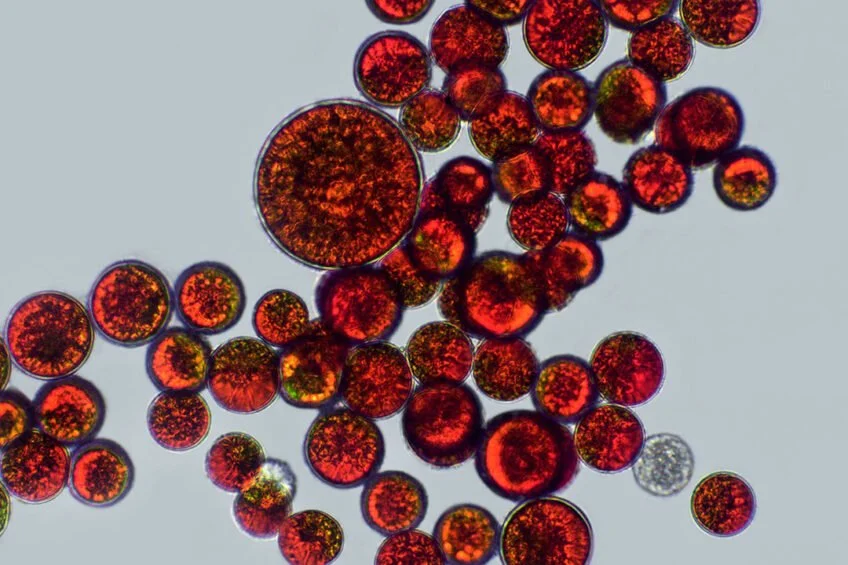The Case for Daily Astaxanthin: Performance, Longevity, and Resilience
If you’re committed to getting the most out of every training session–and every year of your life–small daily habits compound into big results. One smart addition that’s earned a spot in many high‑performing athletes’ routines is astaxanthin, a deep-red carotenoid found in microalgae (and the reason wild salmon has its vivid color). As a potent, fat‑soluble antioxidant, astaxanthin integrates into cell membranes, where it can help defend against the oxidative stress and wear‑and‑tear that training, and modern life, deliver.
Athletic and Physical Performance
Training is controlled stress. The adaptations you want–strength gains, longer endurance, sharper neuromuscular control–arrive alongside increases in reactive oxygen species (ROS), or free radicals, that can contribute to fatigue and delayed recovery if left unchecked. Astaxanthin’s value lies in its unique ability to embed across the lipid bilayer of cell and mitochondrial membranes, where many exercise‑induced free radicals are generated.
What that can mean in practice:
More resilient performance under load: Research suggests astaxanthin may help support time to fatigue, maintain power output, and protect lipids in muscle cell membranes during intense sessions.
Smoother recovery: By supporting the body’s management of oxidative stress, astaxanthin may reduce the subjective edge of post‑training soreness and help you come back fresher for your next lift or interval day.
Eye and skin support for outdoor athletes: Its protective role extends to tissues exposed to light and environmental stressors, relevant for long rides, runs, and court time.
While outcomes vary by individual and protocol, the takeaway is consistent: astaxanthin helps create conditions for better training quality over time.
Longevity and Optimal Health
Longevity isn’t just lifespan–it’s healthspan. Oxidative stress and chronic, low‑grade inflammation are common threads in biological aging. Because astaxanthin positions itself where membranes are most vulnerable, it helps preserve the integrity of cells and mitochondria–the foundation of your metabolism.
Potential whole‑body benefits include:
Cellular resilience: Support for mitochondrial membranes may help maintain energy production as training volumes and life demands increase.
Brain and eye health: As a lipophilic antioxidant that can cross the blood brain barrier, astaxanthin supports tissues with high oxidative workloads.
Skin vitality: By buffering environmental stressors, it can contribute to a healthier skin barrier, which is an often-overlooked part of overall wellness.
The result isn’t a quick fix, but a smarter environment for your body’s maintenance and repair systems to do their best work daily.
Support for a Healthy Inflammatory Response
Inflammation is not the villain, it’s an essential signaling process for adaptation. Problems arise when that response is excessive or lingers. Astaxanthin has been shown to modulate key pathways involved in the inflammatory cascade, helping the body strike a favorable balance: enough inflammation to trigger progress, not so much that it impedes recovery or performance.
For busy professionals and athletes juggling high training loads, travel, or disrupted sleep, this steady “nudge” toward equilibrium can be especially valuable.
How to Use Astaxanthin
Typical daily dose: 4-8 mg with a meal containing healthy fats; some protocols use up to 12 mg. Start on the lower end and give it 4-6 weeks to assess.
Source matters: Look for naturally sourced astaxanthin from Haematococcus pluvialis microalgae. Third‑party testing and transparent quality standards are non‑negotiable.
Pair intelligently: It stacks well with omega‑3s, vitamin D, magnesium, and a protein‑forward nutrition plan to support training and recovery.
Who Might Benefit Most from astaxanthin
Endurance and power athletes pushing volume or intensity blocks
Masters athletes prioritizing recovery and joint comfort
Outdoor trainees with high sun exposure
High‑stress, time‑compressed professionals seeking consistent energy and resilience
As always, supplements complement–never replace–personalized programming, quality nutrition, sleep, and stress management. If you’re pregnant or nursing, on medications (especially anticoagulants), or have specific medical conditions, speak with your healthcare provider before adding astaxanthin.
Ready to integrate astaxanthin into your routine? Ask Joe for personalized guidance on timing, dosing, and sourcing to align with your training phase and goals.
Supporting Materials
Athletic and physical performance
Brown et al., 2021. J Sci Med Sport: 12 mg/day for 7 days improved 40 km cycling time-trial performance and increased fat oxidation in trained men (randomized, double-blind, crossover).
Earnest et al., 2011. Int J Sports Med: 4 mg/day for 28 days improved 20 km cycling time-trial performance and power output in competitive cyclists (randomized, placebo-controlled).
Tsao et al., 2025. BMC Sports Sci Med Rehabil: 28 mg/day for 4 days increased time-to-exhaustion and reduced markers of oxidative stress/muscle damage in young men (randomized crossover).
Waldman, 2024. Nutrients (Invited Review): Overview of astaxanthin’s antioxidant/mitochondrial mechanisms and practical implications for endurance athletes.
Brown et al., 2018. Frontiers in Nutrition (Review): Synthesis of human and animal data on exercise metabolism, performance, and recovery with astaxanthin.
Inflammation and recovery
Jabarpour et al., 2024. J Cell Mol Med: 12 mg/day for 8 weeks lowered TNF-α, IL-6, and IL-18 in women with PCOS; modulatory effects on ER-stress/apoptosis pathways (randomized, double-blind, placebo-controlled).
Talukdar et al., 2020. Biomed Pharmacother (Review): Mechanistic review summarizing inhibition of NF-κB, JAK/STAT, COX-2, and pro-inflammatory cytokines (IL-1β, IL-6, TNF-α) by astaxanthin.
Systematic Review & Meta-analysis, 2024. ScienceDirect: Evidence summary in athletic men indicating improvements in total antioxidant capacity and potential performance effects.
Longevity and optimal health
Ambati et al., 2014. Marine Drugs (Review): Comprehensive review of astaxanthin’s sources, bioactivity, antioxidant properties, and broad health applications (cardiometabolic, neuroprotective, etc.).
Chalyk et al., 2017. Nutrition Research: 4 mg/day for 4 weeks reduced systemic oxidative stress and improved skin surface morphology associated with aging in middle-aged adults.
Dosing and safety
Brendler & Williamson, 2019. Phytotherapy Research (Safety Review): Review of 87 human studies; natural astaxanthin well tolerated across 2–24 mg/day with no major safety concerns; discusses regulatory ADI differences and natural vs. synthetic forms.
